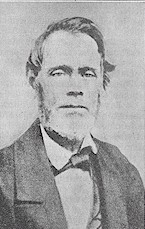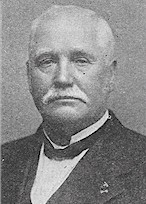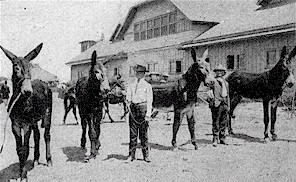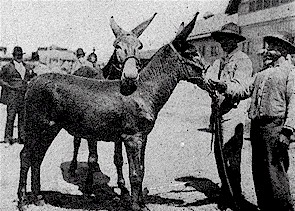Ag
History Intro Page
Jack & Mule Intro.
Early History
1820's & 1830's
1840's & 1850's
Civil War
1880's and after
Notable Breeders 1
Notable Breeders 2
We also have jack and mule results from the 1904 World's Fair

|
Nathaniel Leonard |
 |
Col. Louis M. Monsees |
|

|
Nathaniel Leonard
Nathaniel Leonard is one of the most important Missouri
pioneer settlers who improved livestock of all kinds. Mr. Leonard is perhaps best
known for breeding Shorthorn cattle, but he was responsible for bringing the first
imported jacks to the state of Missouri. The jacks were imported from the island of Malta
in the spring of 1838. Leonard paid $800 for a brown jack in early 1839. This jack
had been imported from Malta and then selected in New Orleans by David Workman and Philip
Thompson of New Franklin, MO. By March 1840, Leonard had paid $818 in full for the
jack. After they selected the jacks, they were probably shipped by boat up the
Mississippi and Missouri Rivers to New Franklin. Nathaniel Leonard became one of the
leading breeders in jackstock.
|
Col. Louis M. Monsees
Col. Louis M. Monsees of Smithton, Pettis County, was
considered to be the king of jackstock breeders in the United States. In March 1905, Mr.
Monsees sold a number of jacks and jennets that averaged more than any other sale in the
country at that time. At the St. Louis World’s Fair in 1904 the Monsees collection of
jacks and jennets made a brilliant record. They won fourteen gold medals and diplomas.
They also won the greatest amount of cash won that was won by any other exhibitor of
livestock of any category. Mr. Monsees held the undisputed rank as the foremost breeder of
jackstock in the country. Mr. Monsees achieved his great reputation as a constructive
breeder through the use of two beautiful sires - Limestone Mammoth and Orphan Boy. Orphan
Boy had a remarkable career as a show animal in the hands of Mr. Monsees. He was never
defeated in the show-ring, and was also a great breeding jack on mares and jennets.
Monsees praised the merits of mules about 1917,
predicting that "There are too many countries and places where the tractors or
other motors cannot fill the place of the mule.... as the mule is the best of all working
animals." He also wrote, "The mule is by far the best and
cheapest to operate large farms with, especially sugar and cotton plantations, where horse
power is used...... mules can be unharnessed when the day's work is over, turned in this
corral or lot where there is a tank full of water, a trough full of grain and rack full of
hay without any danger whatever of a mule over-eating or over-drinking himself, or of
having colic or getting foundered, etc., and there is no danger of these mules kicking and
hurting one another. The mule is too smart to over-drink or over-eat, or to be hurt by
another mule." |

Monsees' Limestone Valley Jacks, ca. 1903

|
J. W. Givens
J. W. Givens of Fayette, Missouri, had also been one of
the leading breeders in the state. His career in breeding was marked by more than ordinary
success. He bought what he considered, “the best jack in the world,” Legal
Tender. Legal Tender had won several championships and grand championships and did not go
undefeated during his show career.
|
John C. Huckstep
John C. Huckstep was born in 1868 in St. Louis County,
Missouri. In 1910 after eighteen years in the business of breeding he had become a
well-known breeder. He had brought many good jacks from Kentucky to Missouri and
distributed them throughout the state. Huckstep died in 1923, at the age of fifty-four.
However, John C. Huckstep left a behind a legacy, and it was said that, “his life had
been an open book, generous to a fault, both with his family and the needy.” |
|
| |
|
References - Ashton, John.
1924. History of Jack Stock and Mules in Missouri. Missouri State Board of
Agriculture. Volume XXII, Number VIII. Horses
and Mules, 1917. Missouri State Board of Agriculture. Jefferson City, MO. |



